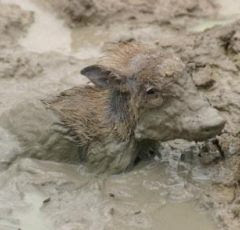Much is being written lately about 'Pipelines by Rail' especially in light of the ferocious headwinds that the proposed Enbridge Norther Gateway, Keystone XL and Kinder-Morgan expansion are running up against from a wide range of folks including environmental and indigenous groups. For instance, the Keystone XL pipeline is not only opposed by a the coalition in Nebraska that stopped its approval but now faces an organization called 'Don't Mess With Texas' that includes TEA Party members, Occupy members, ranchers, farmers, environmentalists, scientists, lawyers and celebrities - a formidable group.
Opposition to the pipeline projects in BC is well known, equally formidable and well documented. Many, including The Mud Report, have been saying for some time now that these pipeline proposals are all just straw-men setup to allow our oil industry owned politicians a target to knockdown in favor of the railway option that the 'smart' money has been betting on all along.
Industry experts know that moving standard crude, or the refined product, by rail is nearly twice as expensive as moving it by pipeline. They also know that moving thick heavy oil from Alberta's Tar Sands and North Dakota's Bakkan Shale Deposits by rail is economically competitive. A recent report from Standard & Poor’s found a barrel of diluted bitumen is transported at a cost of $7 by pipeline, compared to $6 to $8 by rail. Heavy oil requires an expensive thinner called diluent to move in pipe. By rail, it moves undiluted, which evens the playing field on transportation costs. And with rail, companies can rapidly switch markets, since rail networks reach most points of the U.S. – including areas, such as the Gulf Coast and California, that pipes from Canada and North Dakota barely touch.
In Canada during 2011 the combination of CP/CN shipped about 12,000,000 barrels of oil, mostly tar sands crap, to California, the Gulf Coast and Eastern Cdn refineries. That's about equal to that year's total of what the existing Kinder-Morgan pipeline transported to Burnaby...and this year the figure will grow big time. By this time next year CP estimates it will be moving 70,000 cars or more out of the North Dakota Bakken tight-oil field alone to refineries across the US.
Each specially built double-lined tank cars can carry 650 barrels of heavy oil that the railways say offers flexibility the pipelines can’t. Because they can scale up or down quickly and because their tracks are in place, they can provide transportation now, while pipeline permitting and construction takes years. That's why S&P's report also said rail has the potential to move crude to the U.S. Gulf Coast from Alberta in about one-fifth the time of pipelines. They also say the capital cost to expand rail infrastructure is about one-tenth that of the cost of adding incremental pipeline capacity.



